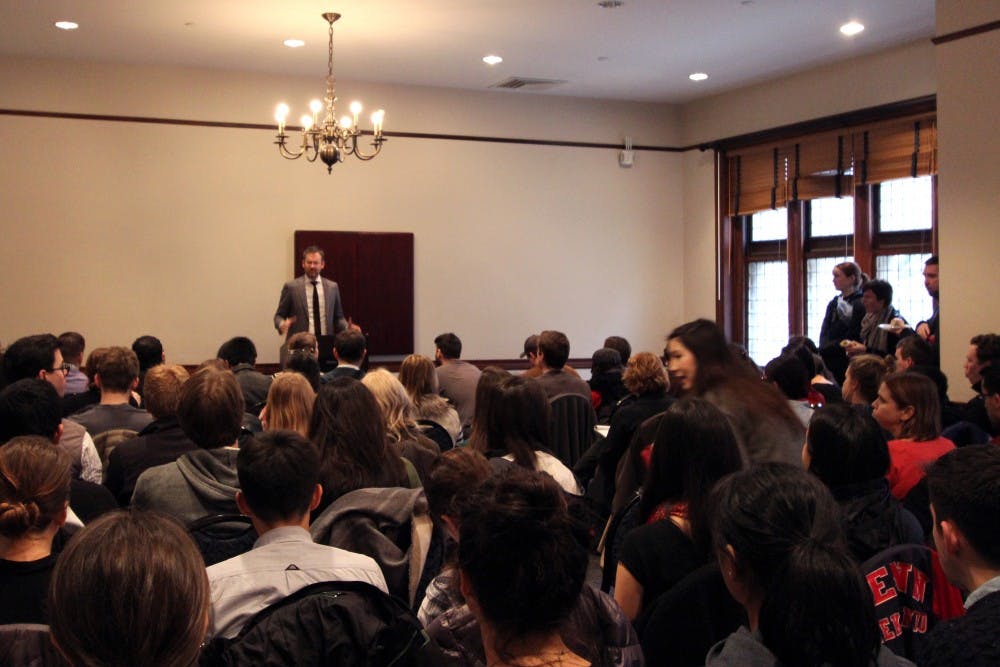
Will McCants of the Brookings Institution discusses his new book, The ISIS Apocalypse: The History, Strategy, and Doomsday Vision of the Islamic State.
Credit: Lizzy MachielseEvery week, the media is filled with reports of ISIS and its latest atrocities. On Feb. 16, Penn hosted a talk in Houston Hall that delved into the question of how the group rose to power.
Will McCants, a senior fellow at the Center for Middle East Policy at the Brookings Institute, director of the Project on U.S. Relations with the Islamic World and adjunct faculty member at Johns Hopkins University, discussed his most recent book, “The ISIS Apocalypse: The History, Strategy, and Doomsday Vision of the Islamic State.”
“How could an organization that failed so stupendously succeed so remarkably?” McCants asked. McCants said that ISIS did not change its formula from the first time it tried to establish a caliphate, but rather the political context changed the second time and permitted ISIS’ formula to succeed.
The formula McCants outlined consists of three parts: focusing on state-building rather than overthrowing an existing state, using extreme brutality rather than trying to win the hearts and minds of the inhabitants and emphasizing apocalypse now rather than later.
McCant applied each of the three parts to two phases of ISIS’ rise to power. Phase I began about 10 years ago and Phase II began about five years ago.
Phase I: Part 1
Al Qaeda discouraged the idea of first restoring the caliphate and then “fac[ing] down the West,” McCants said. Instead, al Qaeda preferred to first get rid of the Americans and then win over the hearts and minds of the Muslim public to establish an enduring state.
Even though ISIS privately pledged allegiance to al Qeada, it was “the laughing stock in Jihadist circles,” McCants said. “The Islamic State demanded to be treated as a state and required other groups to swear allegiance,” which irritated the other rebels.
Phase I: Part 2
Unlike bin Laden, who believed “you have to win over the masses if you’re going to be politically successful,” McCants said, “the Islamic State deeply disagreed ... trying to win over the masses can muddle your political plans ... it is better to be feared than loved.”
Although al Qaeda suggested the Islamic State stop with the beheading videos, “the Islamic State never really changed its stripes.”
This led to the alienation of various Sunnis in 2007-08, which effectively defeated the Islamic State at the time.
“Bin Laden took this as a case of what not to do,” McCants said.
Phase I: Part 3
“Their early leadership was really obsessed with the end time,” McCants noted. The apocalypse is part of Islamic prophecy, with the appearance of a savior, and the Islamic State tried to capitalize on this fear. They tried to set up for the end of the world at the time, but nobody knows when the apocalypse will happen, which led to the Islamic State making some poor decisions.
“These guys were just too extreme to succeed, the assumption went,” McCants said. “And they would collapse under their own weight.”
Phase II: Part 1
Just a few years later, ISIS’ tactics and formula proved successful. With regards to state building, they took advantage of the Syrian civil war, which divided the country.
While other groups were focused on overthrowing the existing Assad regime, the Islamic State’s priority was establishing a state. Assad focused more of his energy on the groups that were trying to overthrow him.
“There was no one to stop them,” McCants noted. In addition to Syria, the Americans had just pulled out of Iraq in 2011, leaving no one to stop the Islamic State there either.
Phase II: Part 2
“Absent a major competitor on the ground,” ISIS proved very successful at getting rid of their opponents, McCants said. They proceeded to “scare the population into submission.”
“Brutality ends up being much more efficient ... it got stuff done,” McCants added. Other groups that governed as coalitions struggled to negotiate with the various factions.
Phase II: Part 3
One part of the formula that changed slightly was the apocalyptic notion. The second time, the group “changed apocalypticism and shifted from the emphasis of a messiah-like figure as fulfillment of the prophecy to the appearance of a state as fulfillment of the prophecy,” McCants said.
The Islamic State was able to successfully use this apocalyptic fear to recruit young people abroad, as Middle Eastern locals were used to this kind of rhetoric. “The belief that the world is going to end can be a pretty big motivator,” McCants noted.
McCants noted in response to a question at the conclusion of the event that in the end, the United States focuses a lot of energy on fighting ISIS, more energy than its allies employ.
“ISIS poses the least threat [to the United States],” McCants said. “And yet we are doing the most to try to destroy it.”
The Daily Pennsylvanian is an independent, student-run newspaper. Please consider making a donation to support the coverage that shapes the University. Your generosity ensures a future of strong journalism at Penn.
DonatePlease note All comments are eligible for publication in The Daily Pennsylvanian.




